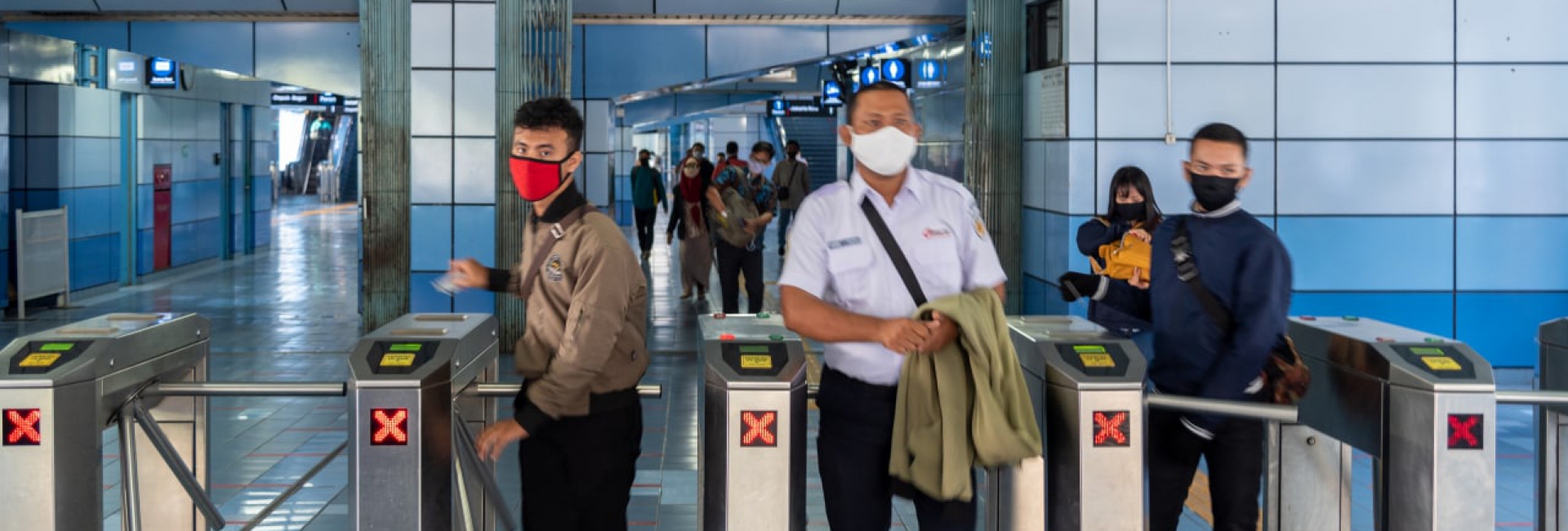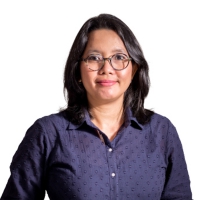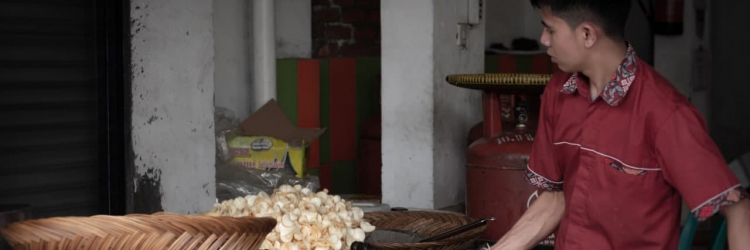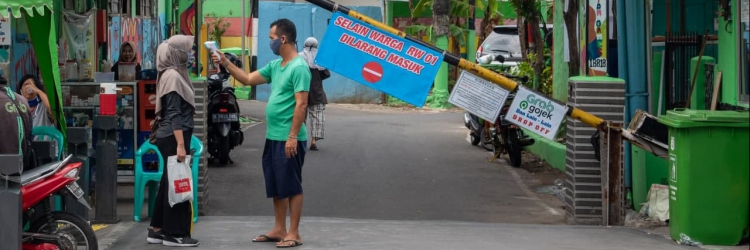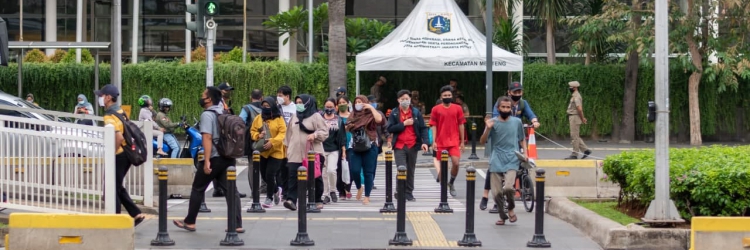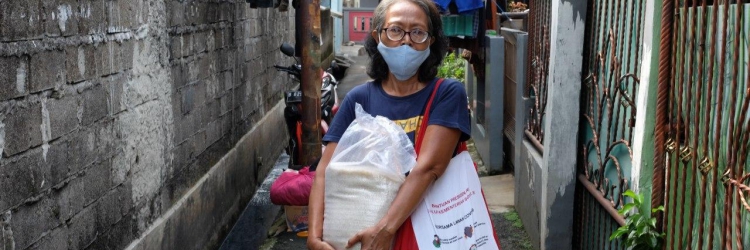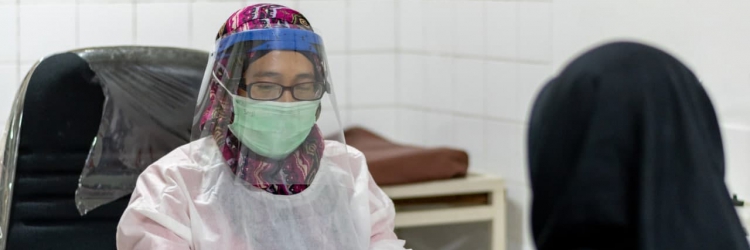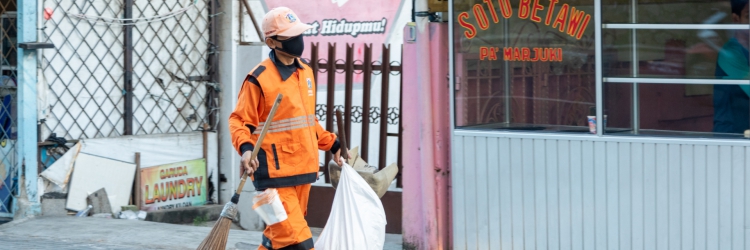Since the COVID-19 pandemic began, Bu Neni[i], who sells food and has a food stall opened in front of her house, now spends most of her time taking care of her grandchildren at home. Especially after her grandchildren's school activities were temporarily dismissed due to the pandemic, both Bu Neni dan her grandchildren have never stepped outside of their house
"I haven't been anywhere. I just stay at home" was the statement Bu Neni repeatedly said to us during our interview session that Saturday afternoon. Selling chips, her new activity for the past month, is done online too; her customers are mostly her neighbors who live nearby.
"I fear the customary sanctions and the risk of having caught the corona if I go outside of my house," said Bu Neni.
Bu Neni is not the only member of the community who claims to be committed to practicing social distancing in her neighborhood, that is, Desa Adat (Customary Village) D, where social distancing has merged within the customary rules. In this village located in Kabupaten Badung, Bali Province, community adherence is shaped by their cognizance of two risks: the risk of getting infected by COVID-19 and the risk of feeling ashamed of receiving the customary punishment for violating the rules.
"The sanction is that we have to listen to hours and hours of preaching from the customary village official, in the presence of the neighbors. So, it's embarrassing," Bu Neni added.
According to the village's pacalang[ii], the customary sanction has been effective in making almost 90% of the villagers comply with the call for physical distancing and restrictions of social activities that may invite crowds. We could tell the pacalang's sense of pride when telling us about the behavior of the villagers. With the strict control imposed by the customary village officials, complemented with the neighbors' monitoring each other, the community's adherence to the health protocols during the pandemic can be established.
Bali Province may not be one of the epicenters of the spread of COVID-19, but it did witness sudden increases in the number of confirmed cases of COVID-19, mainly caused by the Indonesian migrant workers (IMW).
Desa Adat D had once isolated three of its residents who were tested positive for COVID-19. All of them were migrant workers who had just returned to the village. With these three patients in the village, village officials put their hard work to ensure that their village and people were safe.
“Thankfully, they are all now recovered and our village is free from COVID-19. Nonetheless, we continue to coordinate with the relevant parties to monitor the development and situation of migrant workers returning to our village," said the head of Desa Adat D.
Bali is undeniably famous for its sociocultural institution, which stems from their customs. This sociocultural institution is rooted in Hinduism and the local cultural values and wisdoms.
Customary institutions and sociocultural factors play a major role in shaping the community's risk perception of COVID-19. Amid the pandemic, such a high risk perception helps shape the adherence among Balinese people.
Adherence to the health protocols during the pandemic was also found when we interviewed Bu Eni, who had just returned to her village in Purbalingga.
“In general, people here are compliant [with the health advice]. They all wear face masks. Those returning from Jakarta must report to the village administration, have their [body] temperature checked, and are given bracelets indicating that they just arrived. When I arrived, I didn't go anywhere either. I just stayed at home," said Bu Eni.
Unlike in Desa Adat D, the village where Bu Eni lives has no customary sanctions, but its residents adhere to their village officials' instructions. Considering that at least one person in every household works outside the village, such as in Jakarta, the people in this village, in fact, face a high risk of COVID-19 infection. Fortunately, up to the time when the interview was conducted, that is, in early June 2020, no cases of COVID-19 were confirmed.
The comprehension of the risks of COVID-19 and the level of compliance that the community members in Bali and Purbalingga demonstrated are in striking contrast to those of the people residing in one of the densely populated areas in Kelurahan C, East Jakarta, based on the information given by several of its residents. It is safe to say that the comprehension of those living in this area about the risks of getting infected by COVID-19 highly varies; in fact, it tends to be low.
"If we observe, the ratio is 40% and 60% [with the majority having no adequate comprehension]. More people neither wear face masks nor keep their distance, [and] still frequently hang out with their neighbors," said Wardi, who has lived in this area for more than ten years.
According to Wardi, many residents thought,
"Well, we're just hanging out with our own neighbors. We are healthy; they look healthy as well, so no problem."
From our informant's further observation on the socioeconomic condition in this area, it seems to him that level of education influences the residents' comprehension of the risk factor.
“Not implying anything, but most people here have a low educational achievement, so they don't really get it," said Wardi.
Despite the extra efforts made by the RT administrators to urge the community members to follow the health protocols and make them more aware of the COVID-19 risks and its potential transmissions, in reality, ensuring their adherence is challenging.
“Our RT head, in this case, is quite active; he often asks the residents whenever he receives information. For example, he once checked with me first if a piece of information was just a hoax before spreading it to the other residents," said Wardi.
“Warning is certainly given, Ma'am, to whoever gets caught hanging out together or leaving their house while not wearing a face mask. It is the RT head's wife who often reminds them. But it's hard, though. [To obey or not] depends on the person," he added.
On the other hand, consideration about the COVID-19 risks, including the risk of getting infected by it, is also influenced by how close the disease is to us. This is reflected in the behavior found among members of the community in Kelurahan A, one of the middle-class residential areas in the outskirts of East Jakarta. After a resident of one RT in that kelurahan was tested positive, the incident stirred quite a strong reaction and response.
All the adjacent RT had closed the entrance to their area with a roadblock, sprayed their houses with disinfectant, and even strictly monitored its residents who went into and out of their neighborhood.
“We were worried indeed," said Pak Samsu, the head of the RW[iii]
As the comprehension and responses of the community vary in terms of the COVID-19 risks, frequently changing decisions and policies from the central government down to the RT level also influence the community's perception and comprehension about not only the risks of getting infected by COVID-19 but also the economic risks.
The inclination to maintain peace among the community members and to keep them from getting panic prevents community leaders from informing the COVID-19 risks properly.
Even in the community themselves, considerations are frequently not driven by issues related to COVID-19 or how to anticipate it or how to treat residents who have gotten infected with it. In Kelurahan C, for instance, the questions its residents keep on asking are,
"When will the assistance be disbursed?" and "When will I receive the assistance?"
This shows that community members are constantly weighing health risks against economic impacts in their daily lives. Such weighing indicates a contestation between the knowledge that the community has and the information that the government gives regarding the health and economic risks posed by COVID-19. The result of such weighing plays a role in the community's comprehension and their level of compliance with the health protocols.
Easing Off, Boredom, and Consistently High Risk of Infection
“The children have resumed their study on Quran reading in the neighboring RT. In the past, this study was conducted there, but because of the lockdown, this activity had been postponed. Now, the children have gone back there to join the study. Not to mention, now it is the kite-flying season, so the children also play kites," said Bu Era, who also lives in Kelurahan C, East Jakarta.
“My kid also had requested that we go swimming. Usually, every year during Jakarta's anniversary, we get free entry to swimming pools, but I am still scared. And everyone at home has gotten so bored already," she continued.
Currently, Jakarta has been under a transitional phase since the PSBB ended on 14 June 2020. Towards the end of the PSBB, the mass media, including the social media, were filled with guidelines on how to carry out activities during this transitional period, which is often referred to as the new normal.
In Desa Adat D, its residents' activities are said to have increased. Now that the implementation of the Public Activity Restrictions (PKM) has ended, food stalls operate until evening. The main road in front of the village has now looked busy as well, as told by Bu Neni.
“Let's just say, if last time people could have just lied around in the middle of the road and no cars would hit them, now we could not even cross the street easily," she said.
Even Pak Munir, Bu Neni's husband, has started to leave the house more frequently. The company he works for has started contacting their employees to get ready to receive demands for their services. Even though he is not yet to receive his payments, being able to resume the activities he used to do has brought his spirit back.
It is the hope of many that the economic situation can return to where it was once before the pandemic. Bu Neni looks forward to the time she can open her food stall again as well as the long queue of her customers even before the stall starts operating for the day.
In Kelurahan A, the roadblock initially installed to provide a sense of security to its residents has now become a disruption. Amid this hope to resume people's daily activities, including the economic ones, the threat of the COVID-19 infection and its spread remains high. Jakarta and Bali, for example, still have a fairly high increase in the number of daily confirmed cases.
Repelling the False Sense of Security
Since the first case of COVID-19 was announced by the government and three months afterward, public perception of the risks of COVID-19 keeps on changing.
The situations in the four communities above show that the level of comprehension of risks, as demonstrated through community adherence, is inseparable from sociocultural factors and the COVID-19 policy response and handling.
Given the different risk factors faced by every individual and group and the varied community adherence, it is highly important to immediately communicate the risks of COVID-19 to diverse community groups by taking into account their socioeconomic conditions.
A high level of public comprehension of the risks of COVID-19, including the knowledge on the disease' modes of transmission, is highly required to repel the false sense of security which often appears in a disaster context.
For example, as described by Montz and Tobin in their article published in the Geografický Časopis journal, the construction of an embankment by the side of a river as water barrier is an example of a mitigation effort to reduce the risks of flooding which creates a false sense of security. The embankment does not actually help reduce the risks; instead, it increases the security risks of the local community living by the side of the river when it breaks down.
With regards to the COVID-19 pandemic, if the central and regional governments rush to introduce the new normal policy to the community, community members may think that our condition has improved for the better that they can carry out their activities just like they did before the COVID-19 pandemic started. Without community preparedness, which is preceded by correctly comprehending the risks of COVID-19, this policy has the potential to increase the number of COVID-19 patients and harm the economy in the long run.
Considering that the number of confirmed cases of COVID-19 increases by around 1,000 cases per day, and even reaching 2,657 cases as of 9 July 2020, it does seem more and more apparent that this sense of security is indeed false, isn't it?
------------------------------------------------------------------------
[i] The names of respondents in this feature are psydonyms
[ii] According to Regional Regulation of Bali Province No. 4/2019 on Customary Villages in Bali, pacalang is defined as a traditional security unit in Bali established by a customary village and tasked with keeping the security and order of the customary village territory. Pacalang can also refer to the personnel of this unit.
[iii] RW is a unit of local administration consisting of several RT (neighborhood units) within a kelurahan.


